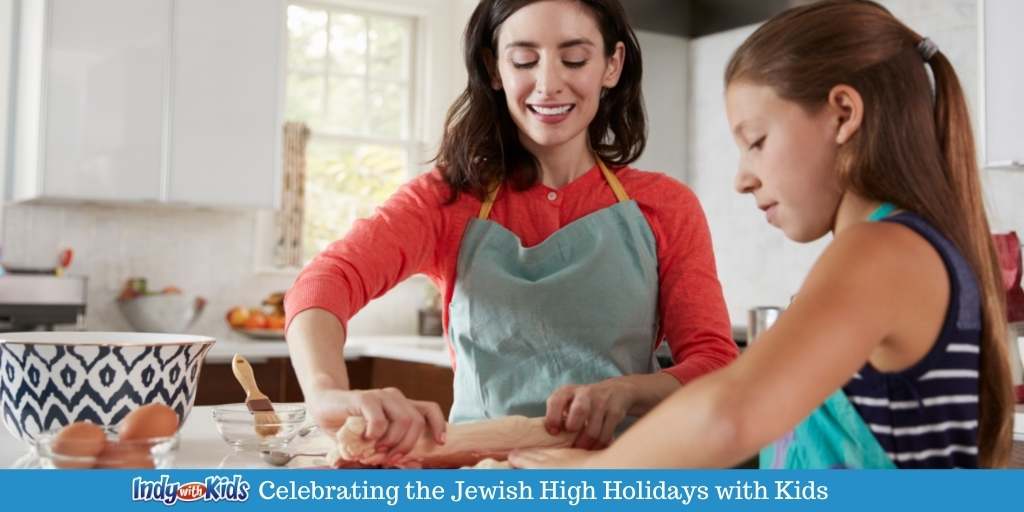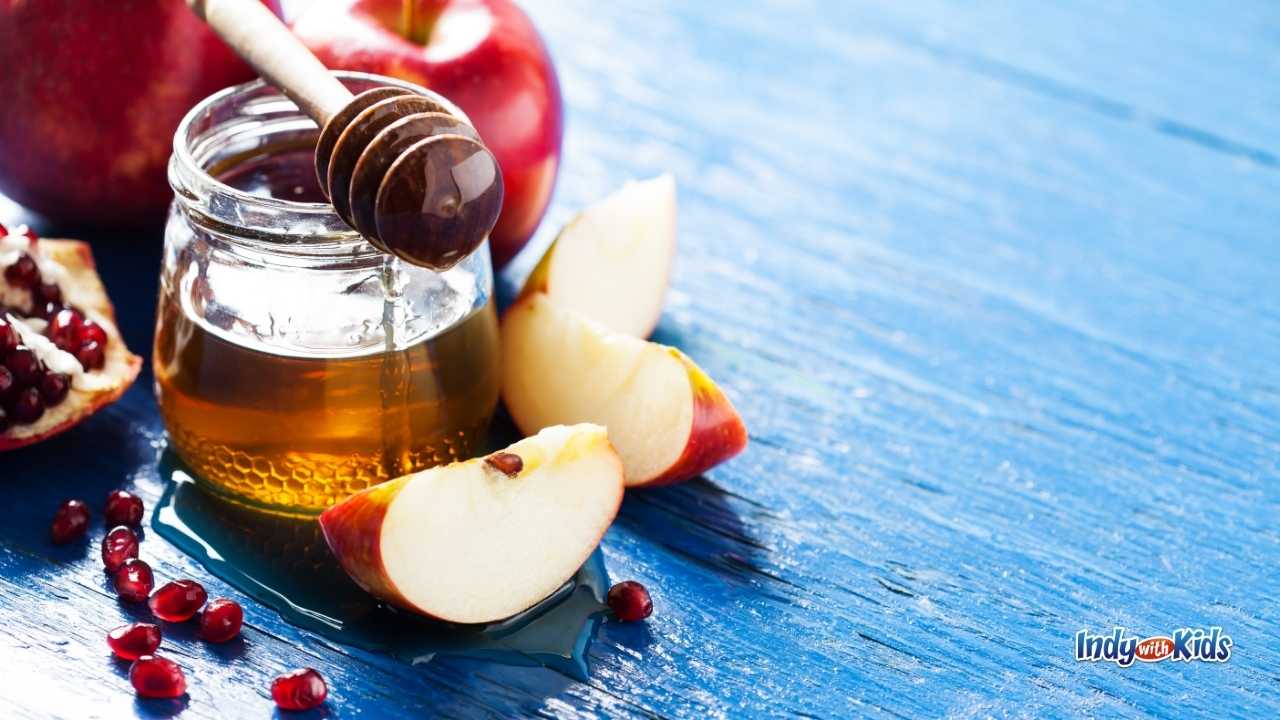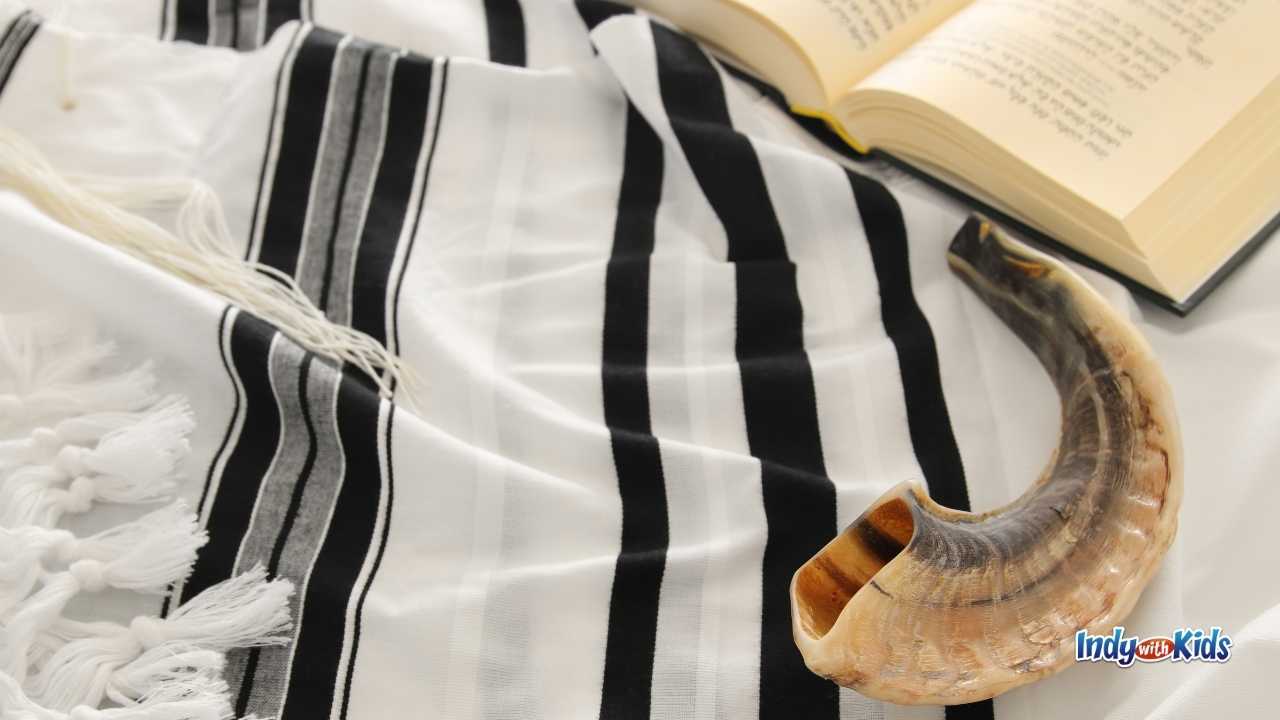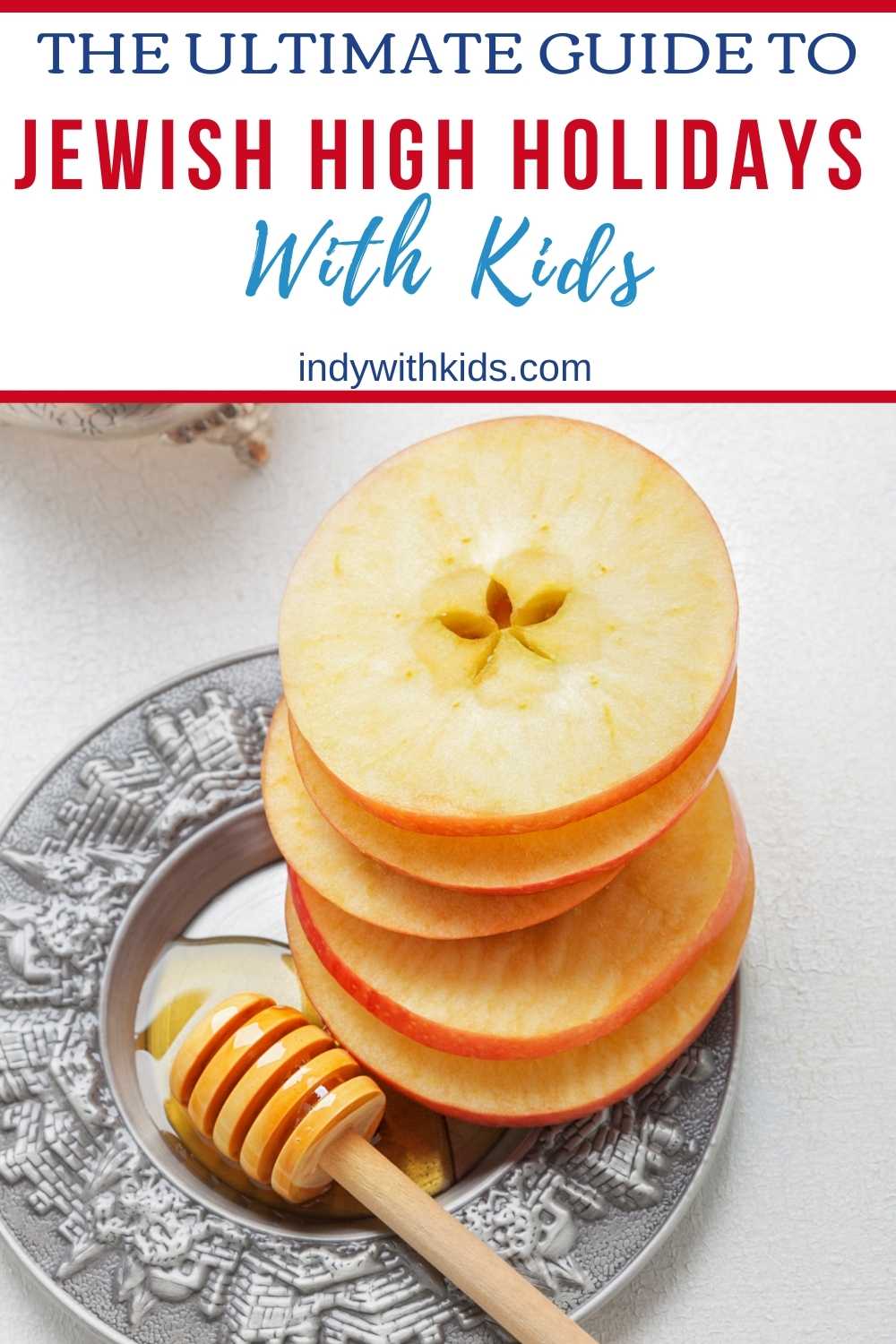For me, one of my greatest joys as a Jewish mother is finding ways to help my daughter gain the best understanding of what her traditions mean, then allowing her the space to create her own moments of connection to her roots. Rather than allowing children to be passive participants through the high holidays, which is certainly easy to do, use the opportunity instead, to draw them into our own processes and create special, impactful moments.
We’ve curated a list of 20 meaningful ways to experience the Jewish High Holidays with your kids, leading up to Rosh Hashanah (beginning in the evening of Sunday, September 25 and ending in the evening of Tuesday, September 27, 2022) and through Yom Kippur (beginning in the evening of Tuesday, October 4 and ending in the evening of Wednesday, October 5, 2022).
The Month of Elul
In preparation for Rosh Hashanah, which is the Day of Judgement and Jewish New Year, we start reflecting on our actions and behaviors of the past year. This takes place during the month of Elul, which is the last month of the year. Elul is a Hebrew acronym for “Ani l’dodi v’dodi li” meaning “I am my beloved’s and my beloved is mine.” The phrase represents the love between the Jewish people and God.
When we take the time to come to terms with our own imperfection, we also accept that no one is perfect. In doing so, we start the process of emotional decluttering to make space for the clean slate awaiting us.
An analogy that can help children relate is by looking at your own relationship with each other. You, the parent, have created this life and established your home with rules and guiding principles. They’ll often say the rules are too difficult, or they don’t feel like doing what is being asked of them. That is where the lesson is! It’s in their own humanity, their free will. But in exercising some of that free will, they’ll occasionally run the risk of frustrating, offending, inconveniencing, etc. They’ve seen it in how you react, how their siblings react, how their friends might react. In easy moments of prompted reflection, maybe on a family walk or while hanging out at the park, children can reflect on choices they’ve made and the impact of those choices, both positive and negative. It’s taking stock of what went right, wrong, and the best course going forward. Was there anyone who they hurt or offended? It’s also an opportunity for parents to open up about their own journeys and model the next steps towards achieving atonement.
Decorate Round Challah Rolls
Undoubtedly, the essential centerpiece of the table for Rosh Hashanah is the special round challah, which differs from the braided loaf eaten during Shabbat dinner. The roundness symbolizes the continuous cycle of life into the new year. I like to buy frozen dough balls because they’re small and my daughter can do lots of little creative things with them. Once thawed, they can be rolled into strands, braided, twisted, coiled, or wrapped into a circle. We like to play around with toppings like raisins, sprinkles, sugar, cinnamon, chocolate chips, chopped apples…the options are endless!
Apple Picking
Apples are sweet and were once believed to have healing properties. On Rosh Hashanah we dip apples in honey to have a happy and sweet new year. One of the coolest parts about living in the Midwest during Rosh Hashanah is that the holiday coincides with apple picking season! There are so many wonderful orchards to “pick” from in central Indiana, with lots of additional family-friendly features like hayrides, corn mazes, petting zoos, and outdoor playscapes. We love to make a day of it, and create wonderful memories in doing so every year.
Apple-Themed Recipes
When we get home from apple picking, which is usually mid-afternoon, I let my daughter pick out several apples from our haul. I peel and core them, and she chops them up with a butter knife. We toss the chunks into the crock pot, add a little bit of water and a dash of cinnamon, then cook on high through the rest of the afternoon and early evening. Right before bedtime, as a special treat, we enjoy a little warm homemade applesauce. The rest goes into the fridge to eat throughout the holidays. There are so many wonderful foods to make with apples, but this is my favorite and how we love to bookend this special day.
Puffy Apple Playdough
Who doesn’t love some sensory fun? Try this simple recipe for some hands-on fun.
Ingredients
- 2 c. cornstarch
- 1 c. inexpensive apple-scented conditioner
- Food coloring
Directions
- Place the cornstarch in a large bowl.
- Mix in the hair conditioner with your hands–it will just start coming together and it will be pliable and very, very smooth. If desired, add a drop or two or food coloring.
Honey
Honey-coated everything throughout Rosh Hashanah! Honey signifies the hope that the new year will be sweet. In addition to beautiful apple orchards, Indiana has some truly fascinating honey farms and apiaries. The one we love lets you decorate your own honey bear and has a self-filling honey station. You are also able to make your own beeswax candles, and then use them for the holiday candle-lighting. There’s also really delicious local honey available at farmers markets and select grocery stores. If you don’t have a honey pot, you can slice the top off an apple, scoop out the inside, and then pour the honey into it. It’s so cute and adds another fun element to your table.
Honey-Themed Recipes
My daughter and I are obsessed with ice cream, especially homemade ice cream that only takes a few minutes to make!
Honey Ice Cream
For Rosh Hashanah I tweak our plain old vanilla recipe and turn it into a luxurious honey ice cream.
Ingredients (makes one serving)
- 1 c. room temperature half-and-half
- 1-1.5 T. honey
- pinch of sea salt
- pinch of cinnamon (optional)
- 3 c. ice
- 1/3 c. kosher salt
Directions
- In a bowl, whisk half-and-half, honey, sea salt, and cinnamon (optional) until combined. Pour into a small resealable plastic bag. Push out excess air and seal.
- In a larger resealable plastic bag, combine ice and kosher salt. Place the small bag of ice cream ingredients inside of the bigger bag and shake vigorously, approximately 10 minutes, until ice cream has hardened. (PRO TIP: This activity can be made even more fun by turning up some music and throwing a mini dance party in the kitchen!)
- Remove from the bag and enjoy! Bitayavon!
Honey Slime
While we are at it with sensory play, why not try this edible and non-toxic honey slime?
Ingredients
- ¼ c. honey
- ¾ c. cornstarch
- 1-2 T. vegetable oil (optional)
Directions
- To start making your honey slime, you will heat the honey in the microwave for 30-45 seconds. CAUTION: IT WILL BE VERY HOT!
- After removing, add the cornstarch 2 Tablespoons at a time, until completely incorporated into the honey.
- Then start kneading the cornstarch in once the mixture gets too thick to stir.
- Continue kneading the slime until it is no longer sticky and well mixed. If the dough is still sticking to your hands after kneading for a few minutes, just add a bit more cornstarch. Vegetable oil can be added as needed, until the slime is stretchy and not sticky.
- Have Fun!
DIY Rosh Hashanah Cards
Send your family, friends, and neighbors the sweetest, homemade new years cards, made exclusively by your kiddo! Use card stock or a section of construction paper for the card. Next, cut an apple in half from top to bottom and that use it as a stamp! Dip the flesh side of the apple in washable, non-toxic paint. Then press it onto paper and ta-da! The customary greeting for Rosh Hashanah is “L’shana tova” meaning “for a good year,” so be sure to add this to your card.
DIY Challah Cover
When challah is placed on the table for Shabbat or a special holiday like Rosh Hashanah, it is covered in a decorative cloth. This is because there is an order, or a hierarchy, to the blessings being said. The first blessing is said over the candles as they are lit, the next blessing is over the wine, and the very last blessing is over the challah. Well, we feel a little bad for the challah since it was last to receive our attention. After all, challah IS lovely and delicious! So we place a beautiful cover or “veil” over it, and when it’s time to say the hamotzi (blessing over bread), the challah is unveiled and everyone typically gasps and smiles. Kids and family members can make a cover for the special round challah. All you need is a piece of cloth large enough to cover the challah. Beyond that, you can use markers, paint, tye dye, bedazzle… possibilities are endless! Have fun!
Jewish High Holiday Songs
My daughter and I are always singing songs together. Many times our songs are silly and goofy and completely made up. Other times, they are real and make actual sense! Here’s a couple that top our charts during high holidays:
Apples & Honey
“Dip the apple in the honey,
Say a bracha* loud and clear!
L’shana tova u metukah,
Have a happy sweet new year!”
*Bracha is Hebrew for Blessing.
Shofar Blast
“I love to hear the shofar* blast
Sometimes slow and sometimes fast
I love to hear the shofar blast
Happy happy happy new year!
Tekiah!* Shevarim!* Teruah!* Tekiah Gedolah!*
I love to hear the shofar blast
Sometimes slow and sometimes fast
I love to hear the shofar blast
Happy happy happy new year!”
*Shofar – ram’s horn
*Tekiah – One long note, meaning the summons.
*Shevarim – Three medium length blasts, representing the sound of weeping.
*Teruah – Very short staccato sounds, as an urgent alarm.
*Tekiah Gedolah – One very long note, representing The Great Tekiah.
Jewish High Holiday Books
Reading together is always a favorite quality time event. Even better is being able to learn about your traditions and feel represented in the stories we read together. Some great options during the High Holidays are “Rosh Hashanah is Coming!” by Tracy Newman, “Tashlich at Turtle Rock” by Susan Schnur, “The Hardest Word” by Jacqueline Jules, “Is it Sukkot Yet?” by Chris Barash, “Maya Prays for Rain” by Susan Tarcov, and “Simchat Torah is Coming!” by Tracy Newman.
Tashlich
After Rosh Hashanah services, my daughter and I perform a ritual that symbolizes casting off one’s sins of the previous year, either by throwing pebbles or breadcrumbs into flowing water. It’s incredibly meaningful and powerful. If you aren’t quite ready to stand beside a rushing river or stream with your little ones in tow, I get it and I’ve been there! You can recreate this activity in an engaging way at home with bath crayons or washable markers. Have your children draw or write the things they are sorry for on the inside of the tub or shower. When they are finished, turn on the water and watch them wash away!
Atonement
So the process of atonement has four stages. Allow your children to be privy to a couple things you’re atoning for, if you’re comfortable in doing so.
The first step is to devote time for reflection, in order to find the actions you’re sincerely regretful about. Once you you it in mind, put an end to the action, if it is still ongoing. Verbalize your mistake and ask the wronged party for forgiveness. If you are forgiven, find a way to right the wrong in the form of restitution. Finally, commit to not repeating the sin in the future.
Yom Kippur Activities
When you aren’t eating or drinking for 25 hours and you have children, it helps to have a plan in place at home. This plan should respect your need for minimal energy output, as well as the children’s need for stimulation and activity. My daughter calls Yom Kippur “the day the grown ups don’t eat and are miserable.” She’s not at all wrong! I’m lucky, though, because she’s very empathic and lays low during this time. My advice is to plan ahead and set up activity stations in the house before you leave for Kol Nidre services. This way, they’ll be ready when they wake up in the morning, and can remain out all day. Puzzles, sensory bins, board games, a cozy reading nook, and construct-a-fort are all great options. It’s going to vary based on your children’s ages and interests.
Yom Kippur Menu
I assemble a tray of grab-and-go food for my daughter, so I don’t have to prepare or touch any food on Yom Kippur. A few days before YK, I sit down with my daughter, and we make a menu of the food she’d like to have. It’s typically fresh veggies, fresh fruit, crackers, chips, yogurts, treats, boiled eggs, cheese, bagels and cream cheese, juices boxes, and bottled waters. We go grocery shopping and I portion everything out, putting servings into baggies so she gets enough food. I organize the tray and set it low in the fridge. She honestly looks forward to the independence she has that day. If your children are younger, infants and toddlers, while they are more dependent you can still get everything assembled and grab the items for them. Minimizing meal planning efforts makes the day easier, so you can still focus on prayer and rest.
Sukkah Construction
For the holiday of Sukkot, we construct huts that are reminiscent of the dwellings of our ancestors who roamed the desert for 40 years. It’s a joyful time, full of gatherings and parties in friends’ sukkahs. All meals are eaten in the sukkah. It’s just a fun and cool place to hang out! We have a portable sukkah that we like to use at home, but also take to serene locations to picnic and hang out. Sukkahs have 3 walls with a sparse roof made from natural materials that allows you to still see the sky and stars at night. We like to decorate the inside with twinkle lights, cute drawings, and artwork made by my daughter. If you don’t have the space or time to make a sukkah for your entire family, there’s still a lot of really fun things you can do! In keeping with the very general blueprint of 3 walls and a thin roof, you can make a small one out of Legos, blocks, popsicle sticks, etc. When my daughter was little, we made a mini one from a large Amazon box and she played in it for days! You could even take a small table and turn it on its side, fashioning a couple walls out of blankets and some branches for the roof.
DIY Lulav & Etrog
Possibly the oldest recorded tradition in Judaism are the lulav and etrog. They are comprised of the 4 species, which symbolizes the 4 different types of Jews coming together: willow branch, palm branch, myrtle branch, and the etrog, which is a citron. Children can look up what each type looks like, constructing them out of paper, and then play with them in their mini sukkah.
Shemini Atzeret
On Shemini Atzeret, we pray for rain and for the rainy season to commence. It’s an auspicious time to ask for something, seeing as how rain is out of our control, and at the same time we’ve atoned for all wrongdoing. Our intentions and hearts are totally pure and it’s completely up to God. It’s an interesting time to discuss the water cycle with children. We’ve completed the cycle of the year, so the nature of cycles is fresh in their mind. We’ve performed the ritual of tashlich with them, which involves water, and they’ve seen our own cycle of transformation as the holidays have progressed. So it’s a good time to introduce that even water changes its appearance, flow, and form through time.
introduce that even water changes its appearance and flow and form through time.
Simchat Torah
The yearly cycle of Torah reading is completed on this day. We celebrate by taking all of the Torah scrolls out of the ark, and spend the evening dancing with them, singing and rejoicing. To commemorate the end of one cycle and beginning of another, allow your child to pick out their favorite book and read it from beginning to end several times, pointing out that there is a BEGINNING, an ENDING, but that the action of reading is ONGOING. The Torah is Judaism’s favorite book. We love to hear it, learn from it, and celebrate having it.












